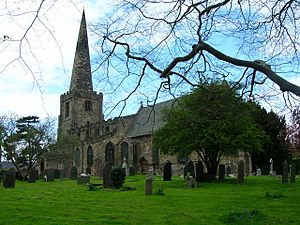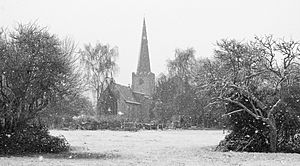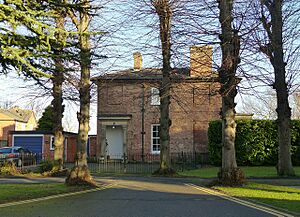All Saints' Church, Sawley facts for kids
Quick facts for kids All Saints’ Church, Sawley |
|
|---|---|
 |
|
| 52°52′37.58″N 01°18′0.47″W / 52.8771056°N 1.3001306°W | |
| Country | United Kingdom |
| Denomination | Church of England |
| Churchmanship | Broad Church |
| Architecture | |
| Heritage designation | Grade I listed |
| Administration | |
| Parish | Sawley, Derbyshire |
| Diocese | Diocese of Derby |
All Saints’ Church, Sawley, is a very old and important church located in Sawley, Derbyshire, England. It is a Grade I listed building, which means it is considered to be of exceptional historical and architectural interest. It is part of the Church of England.
Contents
History of the Church
This church is truly ancient! It was first built around the 1000s. However, most of what you see today was built in the 1200s. You can still find parts from even older times, like the Saxon and Norman periods.
The church has been repaired and updated many times over the centuries.
- In 1838, some parts of the church were fixed up.
- In 1865, the chancel (the area near the altar) was repaired.
Big Changes in 1889
A much bigger repair project happened in 1889. This work cost about £2,000, which was a lot of money back then!
- The old oak roofs were in bad shape, so they were repaired.
- The lead covering on the roof was redone.
- The floors in the main part of the church (the nave) and the side aisles were replaced. They used wood blocks on concrete for under the seats and red tiles on concrete for the aisles.
- Old, tall wooden pews were replaced with new, square oak benches.
- The ground floor of the tower was prepared to be used as a vestry (a room for clergy robes).
- The three bells in the tower were rehung by a company called John Taylor and Co. They also put in a new bell frame.
- The church officially reopened on October 23, 1889, with a special ceremony led by the Bishop of Southwell.
Updates in 1911
More work was done in 1911:
- A new floor was put into a chapel area.
- The old table was replaced with a new altar.
- New rails were added around the altar.
- The choir stalls (where the choir sits) were repaired.
- A stone screen was restored.
- New heating was installed in the nave and chancel.
- An old porch was also repaired.
Memorials and Graves
Inside the church, you can find several memorials:
- The chancel has memorials dedicated to the Bothe family.
- The south aisle has a memorial for Edward Edmonson, who passed away in 1589.
- At the west end, there is a plaque for John Trowell, who passed away in 1766.
- The north aisle has two old stone figures from the 1200s. It also has a stone slab for Richard Shylton, who passed away in 1510.
The churchyard (the area around the church) also contains war graves. These are the graves of soldiers and airmen who died during World War I and World War II. There are five soldiers and one airman from World War I, and one airman from World War II buried here.
The Church Organ
The church has a pipe organ, which is a large musical instrument.
- An earlier organ was installed in 1838. It had a great manual and a tenor C swell manual with pedals. This organ was used until 1905.
- The current pipe organ was installed in 1906 by a company called Harrison and Harrison. It cost £320 at the time.
- It is located on the south side of the chancel.
- The Bishop of Southwell dedicated the new organ on November 12, 1906.
- You can find more details about this organ on the National Pipe Organ Register.
Organists of All Saints' Church
Many people have played the organ at All Saints' Church over the years. Here are some of the organists:
- George T.H. Lodge (around 1891 to 1894)
- Richard Dent (until 1901)
- Charles Hutchinson (1901 to 1945)
- William Dawson (1945 to 1969)
- Peter Tregenza (from 1970 onwards)
The Old Rectory
The parsonage house, also known as the rectory, is where the church's rector or vicar used to live. This building was designed by Henry Moses Wood and built between 1822 and 1824.
Tower and Bells
The church tower holds a set of 8 bells. They are tuned to the key of G. The heaviest bell, called the Tenor, weighs about 497 kilograms (9-3-4 cwt).
- The Tenor bell is the oldest, dating back to 1591.
- Bells number 6 and 7 were made in 1625 and 1658, respectively.
- There were once three other bells (two from 1612) that were lent to St Laurence's Church, Long Eaton. It is thought these bells were broken up when new bells were installed there in 1875.
- The current bells number 3, 4, and 5 were all made in 1893.
- The tower was updated to have eight bells in 1919. This is when the current treble (the highest-pitched bell) and bell number 2 were added by John Taylor & Co.
See also
- Grade I listed churches in Derbyshire
- Grade I listed buildings in Derbyshire
- Listed buildings in Sawley, Derbyshire



